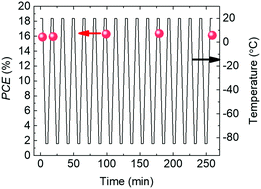In situ investigation of perovskite solar cells’ efficiency and stability in a mimic stratospheric environment for high-altitude pseudo-satellites†
Abstract
Perovskite solar cells with high power-per-weight have great potential to be used for aerospace applications such as satellites or high-altitude pseudo-satellites. The latter are unmanned aircraft exclusively powered by solar energy, typically flying in the stratosphere where the conditions of pressure, temperature and illumination are critically different from that on the earth's surface. In this work, we evaluate the performance and stability of high efficiency perovskite solar cells under a mimic stratospheric environment. In situ measurements under controlled conditions of pressure, temperature and illumination were developed. We show that the cells can operate efficiently in a large range of temperature from −50 °C to +20 °C, with a maximum power conversion efficiency at −20 °C, which is ideal for use in the stratosphere. Besides, performances are maintained after a number of temperature cycles down to −85 °C, representative of temperature variations due to diurnal cycles. An efficient encapsulation is developed, which could be critical to avoid the accelerated degradation of the cells under vacuum. Finally, a promising stability for 25 days of day–night cycles was demonstrated, which suggests that perovskite solar cells could be used to power high altitude pseudo-satellites.



 Please wait while we load your content...
Please wait while we load your content...